#mesopredator
Explore tagged Tumblr posts
Text
Even beyond the horror, disgust, shame, anxiety, sorrow of the present moment in the USA and places brutalized by US influence there are things - banal, difficult things - happening in my life right now that are pretty stressful, but on the other hand we put up a camera last night to spy on whoever’s been stealing from the birdfeeder (a washbear, probably) and it turns out there’s a little gray fox hunting rats in the back yard. I’ve named them Foggy the Fox (it was foggy, there was a fox, really the height of wit) and I hope they reappear. Prance prance prance pounce. Prance. Turn. Watch sniff prance.
18 notes
·
View notes
Text
noun for the tenderness felt towards another person on realizing they're harmless, and have the spirit of the rabbit, and are sort of morally pure in a way you can never be, but are also, because of these traits, damaged in ways you've managed to avoid
#i can never be a simone weil type because i like myself too much & i like everything too much#little mesopredator tearing things up albeit with an extremely conflicted and generous heart
7 notes
·
View notes
Text
Do Now:
Vote in the poll (if still available).
Describe the ecosystem in terms of its distribution of elements (assume that decomposers are abundant, as is oxygen and soil nutrients).
Does this appear to be a stable ecosystem, or one that is soon to change? Why? Discuss with a partner.
#do Now#science#ecology#grades 7-12#OP didn't add mesopredators#I'm worried the food web will become unstable#ironically most real world ecosystems are facing the opposite problem right now
35K notes
·
View notes
Text
Where did this like thing of calling domestic cats "apex predators" come from, like they objectively are not.
1 note
·
View note
Text






Gray foxes are known as mesopredators because they occupy the middle of their local food chain. They feed mainly on smaller animals while avoiding nearby apex predators like coyotes and bobcats. One of their techniques is to climb trees using their powerful hooked claws. They're capable of climbing branchless, vertical tree trunks up to nearly 60ft (18m). ©Texas Backyard Wildlife
591 notes
·
View notes
Note
Is frogs were wizards, what kind of magic would they have?
Look, I think the Basic™ answer is that frogs belong to the Transmutation school of magic because, hello, metamorphosis, but galaxy brain herpetologists know that more than a quarter of all frog species don't have tadpoles.
Toxicologists could tell you of the venomous species that can deliver a real Shocking Grasp that leaves you with Burning Hands—mainstays of Evocation magic.
Ecologists will tell you frogs are pivotal mesopredators and those with tadpoles occupy two trophic niches over their lifespans—classic Abjuration magic.
Some field biologists will tell you how hard it is to find some frogs, even when they are calling from immediately in front of you—archetypal Illusion shit.
Other field biologists might tell you that sometimes frogs start calling a few minutes before the rain actually comes. Obvious hallmark of Divination school.
Conservation biologists will tell you that some species that were declared Extinct or likely Extinct have been rediscovered recently, so I suspect at least some are from the Necromancy school
Behavioural ecologists might tell you that some frogs have familiar pet tarantulas (Big Spider want you to think it's the tarantulas keeping the frogs as pets, but don't be taken in by their biased lies). You want to tell me that they're not Conjuration wizards?
But Frog Fans (Frans) will tell you they belong to the Enchantment school, because hearteyesmotherfucker.gif. I mean, they somehow got you following me, right?
#magic#animals#biology#D&D#frogs#Frans#tasticwolf#answers by Mark#schools of magic#5e#dungeons and dragons
2K notes
·
View notes
Text

Because they groom themselves more, yeah. And because cats are prey animals for many species, they have evolved to have comparatively little in the way of personal scent. But cats who can't groom or are bad at it definitely get greasy after a bit and cat grease is...sticky. Cat grease just doesn't stink the same way dog grease does.
if you've ever pet more than a few dogs you'd Know what dog residue is
45K notes
·
View notes
Text

'The shrarks, once the ocean's most dominant top predators, had, with the coming of various lineages of aquatic hamsters, gradually become deposed from their ancestral niche. Some, such as the galvaprawns, would retreat into the abyssal zone, specializing as bioluminescent predators of the pitch black deep, while others, such as the reefshrarks, would become smaller shallow-sea mesopredators hunting small shrish and pescopods and in turn are themselves prey to the large marine cricetaceans.
The most unusual of the extant shrarks, however, is perhaps the giant prawnda (Oblidognathocaris megalorrhinus), a 1.5-meter long species found around the ocean floor of cooler temperate seas. It is divergent from much of its predatory kin due to its almost-entirely grazing diet: using its broad rostrum and powerful jaw-limbs and their flat crushing surfaces to crunch up coral, quillnobs and particularly red algae, which grows at deeper depths than the preferred forage of herbivorous bayvers that must surface to breathe, being air-breathing mammals. Without such a constraint, the giant prawnda can easily avoid competing directly with the other large herbivores of the sea: a niche all too common in the warm, flooded climate of the Temperocene where rising ocean levels favor vegetation-rich shallow seas.'
-----
#speculative evolution#speculative biology#speculative zoology#spec evo#hamster's paradise#art one shot
98 notes
·
View notes
Text
There's a chapter where the patrol comes across some Sister toms (Beach and Slate), two bachelors living in a gross den who don't know how to cure their own injuries, and Ivy's got a big paragraph of condemning the sisters and how sick and twisted their way of life is. Annoying as ever, but something I expect at this point.
I don't dislike this chapter though, because I am a sucker for the cats just explaining stuff. I like the way they all decide to explain to the two WHY it's important to keep things clean.
....THOUGH I still do need to nitpick about a detail lmaoo, they explain that you want to keep things clean to avoid attracting rats and crows;

Rats would taste just fine to cats, and they are also not MORE likely to bite than any other animals the cats are already hunting. All animals will fight back, and all animals have a risk of spreading diseases. Carrionplace rats are only a problem because they're eating rat poison-- NOT just because they are rats.
(...in fact rats would actually taste a lot better to cats than rabbits, the flavor would be more savory and complex. This is because rats have much higher fat content than rabbits, which are so lean you will actually starve if you only eat them!)
The reason why cats keep their living spaces clean is because they are mesopredators, meaning that larger animals eat them. Messy dens attract foxes and dogs, as well as flies and unwanted insects. Rats and crows are not the reason why you should keep a den clean.
87 notes
·
View notes
Note
i can’t help that feel like 350 calories per cat per day across 5 clans (150 some odd cats!!!) is more prey than there is! even with really generous cooking estimates you’d need to catch a rabbit or two or a large fish or something per clan every single day of the year. i feel like that would really mess up prey populations, wouldn’t it? i know animals have a lot of babies, but 3,650 rabbits’ worth of calories every year (not to mention what other predators like foxes, snakes, and hawks are eating) feels like too much for one territory. are we assuming that there’s more prey than there is or do i just not know how much offspring animals produce?
WELL, there's a lot of factors here, but you are actually organically figuring out something true and horrifying. BB!Cats are sapient, able to understand their impact on the environment and ergo manage it, but feral domestic cats are devastating to local ecosystems.
Not even because of caloric need btw just because of how much they hunt, and their odd behaviors.
The Bad
There is a reason why predator populations are so massively outnumbered by prey species. One rabbit would feed a single cat for days, but one colony is typically 3 - 15 cats. Most predators are solitary, or have "loose" social structures spread out over many partially overlapping territories covering miles (like alligators)! but something changed when cats were domesticated, and they now seek out dense social units unlike their wild ancestors.
That's why the only social wild cats are lions. Lion prides are extremely flexible, ranging from 3 to upwards of 30 members, and their populations are going to depend completely on how much prey they have access to. Even the shocking "infanticide" thing that male lions are notorious for serves an ecological purpose; less lions means more meat, so every cub that isn't yours is a future rival.
(tangent: the largest lion prides actually set up in major migration "hubs," where there is a constant influx of traveling animals. Not really an "ecosystem" where the pride can damage the population.)
But now domestic cats are doing this, in ecosystems that can't support them and never had predators that behave like them. They compete with the local mesopredators ("middle" hunters that hunt small game but are killed by larger predators. Ex: raptors, snakes, caniforms like foxes or raccoons, etc) and put extra pressure on prey populations.
But that's not the worst part.
In nature, there are Predator-Prey cycles. When there's too many predators, they decrease the prey population. When there's not enough prey, the predators starve and their population lowers. Here is a graph of this phenomenon;
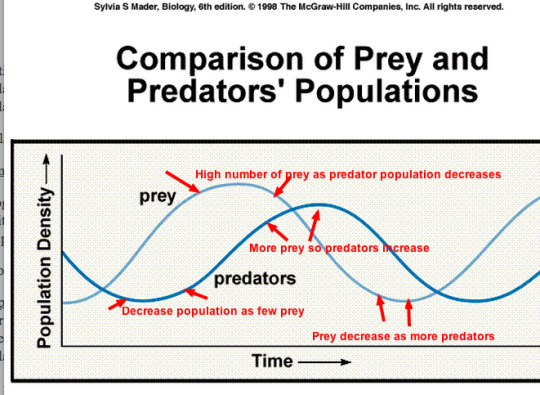
In this way, starvation is required for an ecosystem to stay healthy. It's how nature regulates.
But human beings feed cat colonies.
So colonies end up hitting DOZENS of cats. Upwards of 30 in a tiny area. The sizes you see in canon WC and in BB are TWICE the size of what a feral cat colony typically reaches. In the real world, this is because humans feed them. They HAVE to starve to lower the population, and make no mistake, these are slow, painful deaths.
"But, if we feed the colony, then they're not hunting the local prey, right? Because they're not hungry?" INCORRECT. THEY ARE ANIMALS. Cats are not humans with our sense of morality and long-term consequences. Hunting is only partially driven by hunger, it's also driven by prey drive. Even an outdoor cat, who gets all their meals at home, is killing an average of 90 animals a year.
(note: you may hear the number "they kill 3.5 animals a day." That is a misreading of this study which says 3.5 animals a month based on owner reports; but better study shows they only bring about 18% of their kills home.)
I could get into why I'm actually not a big fan of TNR as a conservation strategy because of this, but in a nutshell, the best solution to feral cat population management overall is (expensive) high-intensity TNR (70% or more) PAIRED with (inexpensive) removal/euthanasia and other methods (like banning colony feeding). PURE high-intensity TNR takes up to 30 years to remove a cat colony in computer simulations. And they keep killing wild animals that whole time.
(tangent: you may come across articles that say that killing feral cats doesn't work. This is often based on this Tasmanian case study by Lazenby et all, where they trapped and removed cats, only to find an influx of subordinate "satellite" individuals that filled the vacuum that the previously established individuals left and increased the overall population. This is a well-documented phenomenon of predator control. They don't tell you that this is short-term and also happens with TNR, just over a longer timeline, as discussed in the above studies, and the solution is to mix methods and make sure that these programs are carried out systemically, NOT ONLY in one limited range.)
So... feral cat colonies with totally realistic needs are very harmful to local ecosystems. They are animals, and they are an invasive species. Keep your cats indoors please
The Good
But BB!Cats and Canon!Cats aren't just animals. These are cats with governments and religion. They do understand long-term consequences.
Even on the page in-canon, they show an understanding that prey comes from breeding (unlike, say, a medieval human who believed in spontaneous generation), WindClan doesn't disturb lapwings during their nesting season showing a basic understanding of ecology, and they even have a law against food waste. Like it or not, these aren't realistic cats. They are small humans with a fuzzy little kitty coat tossed over them.
So we can actually reasonably assume that Clan cats are modifying their behavior so they aren't the ecosystem-shredders that their real-world counterparts are, like;
Hunting over a wider area and having a large territory (so to address you directly anon, their territories are not as small as you might think they are)
Taking the pressure off specific areas by sending their hunting patrols to various parts of their territory
Avoiding hunting animals during their breeding and nesting seasons.
Not killing animals that are pregnant or nursing
Leaving baby animals alone so they grow into bigger food items
Not killing what they don't plan to eat
Intentionally varying their diet so they take a little from many populations.
Hunting animals that real cats don't usually target, like fawns, seagulls, and young boars.
Breeding their own prey, if you're willing to do a little domestication innovation
If you're VERY cool, give them fire. go on. do it. 20% to 50% caloric increase is prettyyy cooool~
But also, you may be underestimating just how many babies prey species produce. Let's use rabbits because these things are insane. They weren't lying, rabbits can breed like rabbits.
European rabbits (and all the domestic breeds they are descended from) have a double womb. That means that when they've given birth to their litter of 4 - 12 babies (usually 6), they can already be pregnant with the next. Gestation is a month. These babies are able to leave their mothers at 2 months and can breed by 4 months. They can have 10 litters a year.
So a SINGLE rabbit COULD have well over 100 bunnies a year... but rabbit warrens are usually 10 - 50, mostly females, plus a bunch of bucks who are more solitary and more likely to travel around. And you're gonna have multiple warrens on a territory.
Low litter estimate, small warren; 10 x 4 x 10 = 400 bunnies. Big litter estimate, big warren; 50 x 12 x 10 = 6,000 bunnies.
That said, most estimates say they functionally end up with 20 adult children a year, which then go on to breed at four months. That's still 200 rabbits a year coming out of that small warren ALONE, and isn't counting the fact that those children are also going to have children of their own.
(though, rabbits in particular are facing a massive crisis in england and even across europe because of two diseases that hit them one after another OTL but it's not related to predation.)
Don't forget that a territory also has more than just rabbits. This is also happening with mice, rats, ducks, sparrows, voles, etc. Like I said, if your cats just diversify the prey they hunt in response to population changes, they'll be golden. In BB I even have a role dedicated to this now; the Head of Hunting, who is tasked with assessing this sort of thing.
SO, to answer you directly;
Feral Cats Bad
WC characters have more in common with a small human than a cat
Pure carnivores are pretty demanding on their ecosystems
There is plenty an intelligent creature can do to reduce their impact on the ecosystem
Their territories could still support them along with the other predators
You did underestimate just how many babies prey animals have, though
Overall, they would be fine. You COULD overhunt a territory, but not with basic prey management practices.
190 notes
·
View notes
Text


Tuffles are ubiquitous, omnivorous generalists. Living everywhere from the frozen tundra to the arid desert, they exist as a staple to many mesopredators' diets. They live in vast underground networks of warrens, producing lots of offspring on the chance that a few may survive to adulthood to repopulate their ecosystems. Pests to some, delicacies in others, there are few species in Aethios more divisive than these rodents. Fancy breeds exist as domestic pets, as well. Some overlaps in these opinions occur in Imp and Dunerunner circles.

24 notes
·
View notes
Text
Selfsimilarity
Whenever it finds another doll - any other inhabitant in these spaces, for that matter - there is always a hint of Jitter. Sway in Purpose, a trace of individuality, queer angles, so many more.
Others serve other Purposes. Different arrangements of sociality, roles to fill, loved ones to mourn and desire. There is selfsimilarity in the other - but only in vague gestures. Dolls also, yet made for different Purposes. Handlers for weak ones, but the packs are always different. Same input, different affect, different force projected onto the world.
....
It has recently come to find another. Witch. Handlerdolls can approximate witches. Mesowitches. (Read up on mesopredators).
To finally find itself - one more of itself - out there. It inspired - nothing and everything. There is no hesitation. No hidden truths, no secrets, for we are already born of the same cosmic stuffs. Our shells animated by the same drive, stalking the horizon of retrocausality and circling the drain around one another.
There is a calm into looking in anothers eyes and seeing your own shimmer refract back at you.
It feels at home, finally. For the only one able to be there for it in entirety - is itself.
#not a person#empty spaces#dollposting#combat doll#inscribings#living dolls#dollvoidism#witchposting#tales from its life
27 notes
·
View notes
Note
After 🦅 for Dracula, do you have other daemon opinions for any of the others too so far?
You bet I do :)
I feel very strongly that Jonathan's daemon is some kind of relatively common garden bird - something like a sparrow, wren or song thrush. Currently a song thrush feels most appealing to me. There's just something that fits for me vibes-wise: small, eager, polite-looking. This doesn't capture Jonathan's core of steel but... I don't know. It just feels right.
I would therefore like Mina's daemon to match in some way - so, another bird. I think her daemon should be an owl, but not a big, impressive-looking owl. Instead, I suggest a little owl - yes, that's what they're genuinely called - which are conveniently only a little bit bigger than a thrush. I like the association with wisdom, but that at the same time little owls are quite round and cute.
(I didn't necessarily intend for Dracula, Jonathan and Mina to have a trio of bird daemons, but I think it works.)
I think Van Helsing's daemon needs to have associations with dedication and hard work, but also be an animal that is in some way a bit odd. Not the full duck-billed platypus but nonetheless out of the ordinary. So: a beaver. And we can pretend that the association with Dutch dam-building and other flood defences is coincidental.
My starting point for Lucy's daemon is that it should be a small mesopredator: a little vulnerable, certainly not a fearless animal, but not a defenceless one either. In His Dark Materials, Pan often turns into an ermine - so, specifically a weasel or stoat in its winter coat - and I like the idea of Lucy's daemon as a white least weasel. It's a very dainty, ladylike daemon, but not without bite.
Finally, I also want the suitors to have a matched set of daemons. This makes no narrative sense - they're good friends, but no one ever suggests that they are particularly alike - but I don't care, I want it anyway. I have two suggestions for this.
One: the big cat society. Eurasian lynx for Arthur - they're extinct in the UK now and have been for hundreds of years, but I like the idea that an old family would have ancient native wildlife among its daemons. And a prestige daemon makes sense for Arthur. Cheetah for Jack, because they look at first like a prestige daemon, but they are also incredibly anxious and definitely the kind of animal that would toy with a lancet while proposing if they had opposable thumbs. And bobcat for Quincey, because Texas.
Two: bunny club. I am strongly influenced by Lee Scoresby here, and I will diverge only slightly by suggesting a black-tailed jackrabbit for Quincey. Arthur has a European hare, which are noble creatures. And Jack has a bog-standard rabbit. The only problem is that no one could believe someone with a rabbit daemon was "absolutely imperturbable" but then I guess Jack does turn out to be very perturbable indeed.
#dracula daily#ask and askance#dracula daily spoilers#daemon au#would love to know other people's takes too
13 notes
·
View notes
Text
The Chacarzo!
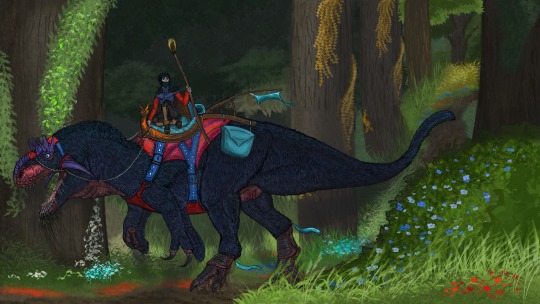
The Chacarzo is probably the definition of how strange dinosaurs can be on Palubolígo in comparison to their convergent analogues on Earth. The Chacarzo is a robust Palutyrannosaur and while far from the most intelligent of dinosaurs, it is at least as smart as modern dogs and researchers in the field believe it to be as intelligent as a chimpanzee. What is strange about this animal is not the intelligence but it's uncanny ability to read emotions in sophont species by smelling hormonal differences and seeing microexpressions. This is a strange thing that is observed in both Fated and free individuals and its explanation is fascinating - the Chacarzo is the longest domesticated species known to exist! The previously thought longest domestic is the Furiosa Garm, a Hyaenodont domesticated about 48 thousand years ago, but as the Chacarzo started its domestication as a medium sized mesopredator which most likely caused the split between the Bloh (Palubolígolian) Folk and the Korvid Folk around 80 thousand years ago.
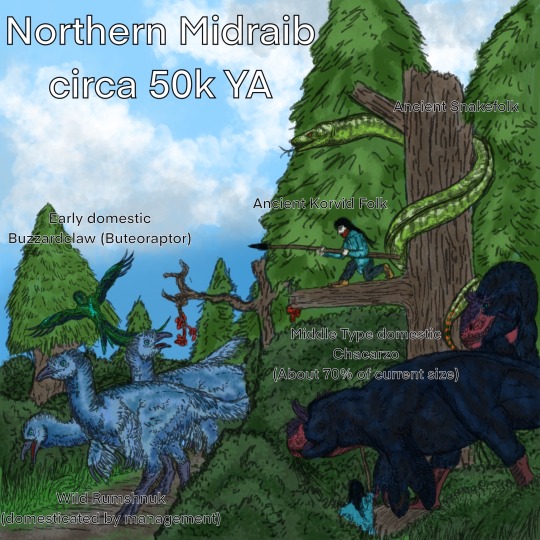
Different breeds of the species
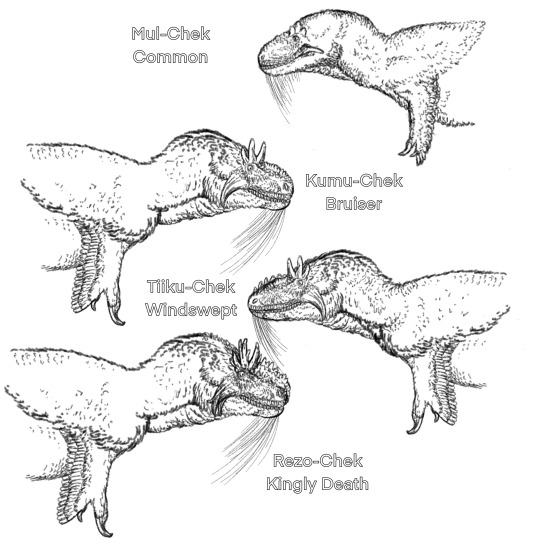
Comparison through time to a large T. rex
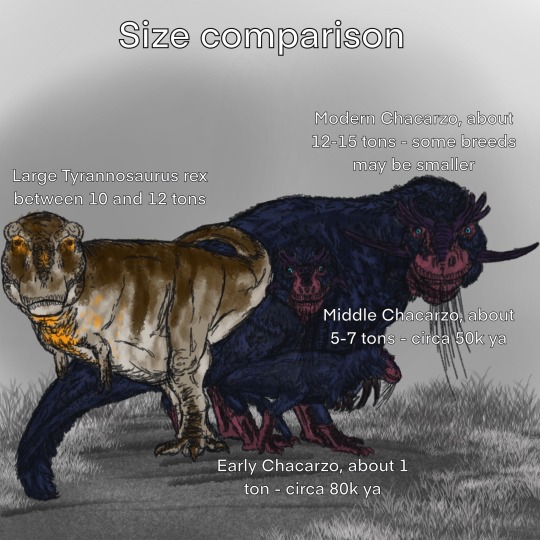
Skull and brain size of the species
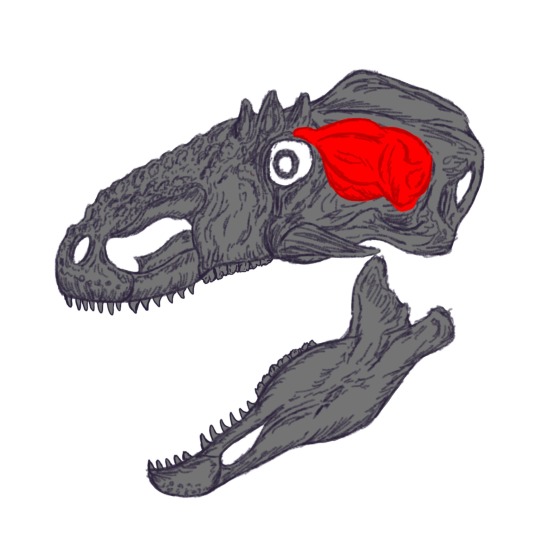
#paluboligo#worldbuilding#speculative biology#speculative evolution#specbio#dinosaur art#dinosaur#theropod
13 notes
·
View notes
Text
PET PEEVE: guys, your housecat is not an "apex predator." your housecat is a mesopredator! that's exactly what it sounds like: a "middle predator" that preys upon lots of smaller animals, but is itself in danger from larger predatory animals (like canids, bears, humans, etc.)
this actually explains a lot about the way cats behave; they're tough and they love killing, sure, but they're also high-strung and tend not to show that they are sick or in pain until it becomes extremely serious-- exactly as you'd expect in a relatively small animal that has to worry about predation, especially a solitary one. their sneakiness and lightning reflexes aid them equally in avoiding death at the claws/hands/wheels of bigger animals (or their machines) and in hunting.
maybe you, like me, find this kind of relatable. many people have a mesopredator mentality! brash, treating the world like a game we're inevitably going to win one moment, freaked out and wary the next. prone to sequestering ourselves behind furniture when injured and yowling at anyone who tries to move or help us.
46 notes
·
View notes
Text
One of my pet peeves is all those posts that refer to cats as 'apex predators.' Like they are highly efficient predators but that's not what apex predator means. An apex predator is a predator that is at the top of the food chain in its ecosystem and is not predated on by other species. So it refers to things like lions, polar bears, etc. Domestic cats (and their wild ancestors) very much get preyed on by other animals in both their native and invasive ranges. Most of the species that predate on them (like coyotes) aren't even apex predators themselves. So cats are mesopredators, not apex predators. We do arguably have a domestic apex predator but it's dogs, not cats.
#you can def make an argument for feral cats serving as apex predators in certain regions they've been introduced to#such as a lot of islands (where they have a devastating ecological impact)#but overall they are not apex predators lol
7 notes
·
View notes